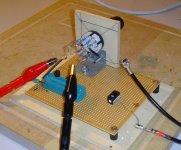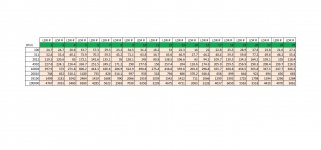I usually match my LDRs to within about 2% across the board from 100 to 100K ohms. I've made my circuit to perform close to a log volume response, although the impedance varies from from 5K to about 90K at the extremes. This means you should have a fairly low source impedance (1K or less) and a high output impedance device such as a tube or FET, ideally with no long high capacitance interconnects. I have a headphone amp (JFET op-amp input) and Tripath amp (about 4K input impedance) as testbeds and they work perfectly.
Last edited:
Post5260
LM358 allows input down to and beyond -ve supply rail. In this case voltages down to zero = ground are being read and give an actual output. Neat opamp for this duty. Especially since it is a dual.
You have the duals picking up the in phase output and the out of phase output. Neat !
Now to the circuit around the BC546b
Is this an active voltage to current generator?
LM358 allows input down to and beyond -ve supply rail. In this case voltages down to zero = ground are being read and give an actual output. Neat opamp for this duty. Especially since it is a dual.
You have the duals picking up the in phase output and the out of phase output. Neat !
Now to the circuit around the BC546b
Is this an active voltage to current generator?
Last edited:
Andrew, the VCCS is described in post#2 in this thread:
http://www.diyaudio.com/forums/tubes-valves/223750-discrete-simple-vccs.html
Best regards - Rudi
http://www.diyaudio.com/forums/tubes-valves/223750-discrete-simple-vccs.html
Best regards - Rudi
I have an idea that might be an interesting way of matching for friends here. Is any way to come forward and to share with Optos? We might find matching in-between members. I can give data of my 21 Silonex NSL-32SR2. That what's left after my matching (I had 25 initially).
You might see matching in your remaining.
In general, I need one more set to build attenuator. I might need more in future, but so far, I need only one to assemble.
You might see matching in your remaining.
In general, I need one more set to build attenuator. I might need more in future, but so far, I need only one to assemble.
Attachments
Last edited:
The issue is that you would need a standardized LDR test jig. If you're testing on your own like most people, then it's fine to use your own standard. But if you want to compare, you need to ensure that everyone uses the same test jig and procedure.
PS. Flipping the column and row in your chart and then sorting by the 100,000 ohm value might make it easier to compare. At least, that's how my mind works.
PS. Flipping the column and row in your chart and then sorting by the 100,000 ohm value might make it easier to compare. At least, that's how my mind works.
Last edited:
Fenris, please do not get me wrong since I succeed to come up with 2 pairs for about 2.9% MAX matched out of 25 pieces. I also have 1 set with 4.4% at 10k (436.6R vs. 456.5R = 4.4%) and all the rest values are below 2.1% MAX. The problem is that I need one more set of two matched Optos. I can buy 25 new pieces from alliedelec.com or to try to find some close optos here in-between members who are willing to give up leftovers or sale them for cheaper price than alliedelec.com sale them.
Last edited:
I succeed to come up with 2 pairs for about 2.9% MAX matched out of 25 pieces. .
If you bought NSL32SR2S you could have had 2 x quad matched sets from around the same amount, which also gives far better log volume control progession.
I've been down the NSL32SR2 path, and there are way too many what I call "mad ones" way out of spec, these are not there with the "S" "sorted ones".
You pay a little more but get much more and they have a more consistant "on" lower impedance.
I believe it's false economy going for the non sorted, too many end up in the bin.
Cheers George
Thank you for all that info.
I sent quotation request to "www.realcomponents.com" (the only one site who has these in-stock now) and they ask for $17.60 for each. Little crazy I guess...
So, I'll continue to monitor market for these Optos availability...
X 24 $4.35 each
Buy Optocouplers Optocoupler; 2.5 V (Max.) @ 16 mA; 25 mA (Max.); 2000 V (Max.); 50 mW (Max.) Silonex NSL-32SR2S online from RS for next day delivery.
Cheers George
Hi, I apologize if is this is not the right place for this question, but I'm using a Lightspeed Attenuator as the volume control in my Dynaco PAS 2 preamp, only problem is I'm getting too much gain, I realise it does not go to zero, but it ramps up quite quickly and most of the time the knob is at around 8 oclock, any ideas what might be causing this? it's sounding fantastic otherwise, my source is I think 100ohms (Scott Nixon Tubedac) then going back into the gain stage, completely stock Dynaco pas circuit
Thanks for any help
Thanks for any help
too much system gain.
Read
http://www.diyaudio.com/forums/diyaudio-com-articles/186018-what-gain-structure.html
Read
http://www.diyaudio.com/forums/diyaudio-com-articles/186018-what-gain-structure.html
OK , so I have too much system gain , don't know how to fix that, not even sure I can in this system, it seems maybe the Lightspeed cannot be used in this way in my System, I think I'll just reinstall the Alps blue pot I had before and leave well enough alone, thanks anyway
Changing gain is pretty easy. Can be done with one resistor. There are a lot of Dynaco buffs on the site. Im sure you can manage it. Other than that you can adapt your lightspeed to your situation by forcing series ldrs to stay high resistance and shunts to move slowly.
I suspect you also have efficient speakers. Efficient speakers and high gain dont work well with a lightspeed because of the minimum value you can achieve on the shunt ldrs.
I suspect you also have efficient speakers. Efficient speakers and high gain dont work well with a lightspeed because of the minimum value you can achieve on the shunt ldrs.
A series pair of the series LDR gives 6dB more attenuation.
A parallel pair of shunt LDR gives 6dB more attenuation.
Combine both for an extra 12dB of attenuation.
Add a switchable 100k in series with the input.
That when added to the doubled up LDRs give an extra 20dB of attenuation.
But far better to eliminate the excess system gain.
A parallel pair of shunt LDR gives 6dB more attenuation.
Combine both for an extra 12dB of attenuation.
Add a switchable 100k in series with the input.
That when added to the doubled up LDRs give an extra 20dB of attenuation.
But far better to eliminate the excess system gain.
I'm using a Lightspeed Attenuator as the volume control in my Dynaco PAS 2 preamp,
Are you sure you need a preamp? The PAS 2 is a pretty horrible design by today's standards, anyway, and has quite a lot of gain (20 dB), so if your DAC outputs a 1 volt signal, after the preamp you'll have 10 volts, which is way too much for any amplifier input.
- Home
- Source & Line
- Analog Line Level
- Lightspeed Attenuator a new passive preamp

